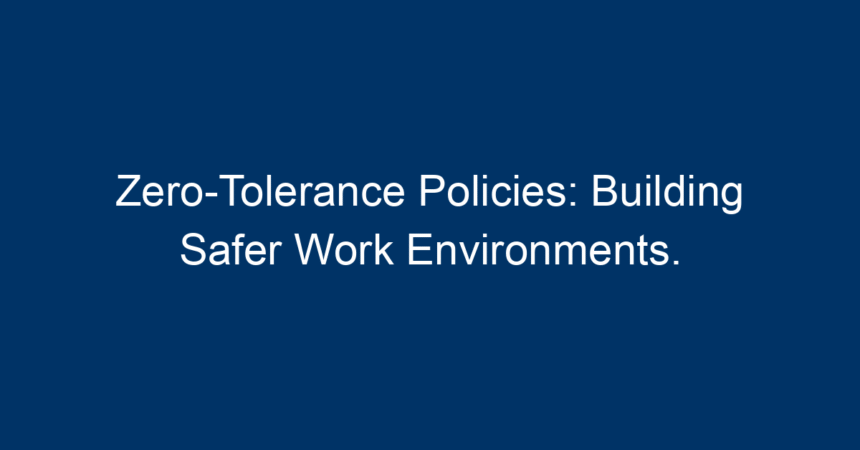In today’s fast-paced and ever-evolving workplace, maintaining safety and security for all employees is paramount. As companies strive to cultivate a culture of respect and accountability, the implementation of zero-tolerance policies has emerged as a crucial framework. This article delves into what zero-tolerance policies are, their importance, and how they can effectively build safer work environments.
Understanding Zero-Tolerance Policies
What Are Zero-Tolerance Policies?
Zero-tolerance policies are strict guidelines that prohibit specific behaviors and conduct within organizations. These policies aim to eliminate unacceptable behaviors—such as harassment, discrimination, violence, and substance abuse—by establishing clear consequences for violations. This approach underscores the organization’s commitment to fostering a safe and respectful workplace for all employees.
The Rationale Behind Zero-Tolerance Policies
The implementation of zero-tolerance policies stems from the necessity to create a predictable and fair work environment. They serve several critical functions, including:
-
Clarity of Expectations: Employees understand precisely what behaviors are unacceptable.
-
Encouragement to Report: When employees know that inappropriate actions will be addressed seriously, they are more likely to report them.
- Protection of Employees: These policies ensure that all employees feel safe and respected in their work environment.
The Importance of Zero-Tolerance Policies
Enhancing Workplace Safety
One of the primary goals of zero-tolerance policies is to enhance workplace safety. By explicitly outlining unacceptable behaviors, organizations can significantly reduce the likelihood of incidents occurring. For instance, a zero-tolerance policy towards workplace harassment sends a strong message that such behavior will not be tolerated, thereby fostering a safer environment.
Promoting Accountability and Responsibility
Zero-tolerance policies promote a culture of accountability. When employees know that misconduct will lead to immediate consequences, they are more likely to think twice before engaging in inappropriate actions. This emphasis on personal responsibility helps cultivate a more ethical workplace culture.
Boosting Employee Morale
A safe and respectful work environment correlates with higher employee morale and productivity. Employees who feel supported and protected are more likely to be engaged and motivated. Implementing zero-tolerance policies reinforces the message that the organization values its people, contributing to a more positive workplace atmosphere.
Implementing Zero-Tolerance Policies
Step 1: Define the Scope
The first step in implementing zero-tolerance policies is to clearly define the scope. Organizations must identify which behaviors will be subject to these policies. Common categories include:
- Harassment (sexual, verbal)
- Discrimination
- Workplace violence
- Substance abuse
- Theft and fraud
By delineating specific behaviors, organizations can ensure employees understand what constitutes a violation.
Step 2: Develop Clear Guidelines
Once behaviors have been defined, it’s essential to develop comprehensive guidelines that outline the steps involved when violations occur. This includes detailing the reporting process, investigation procedures, and potential consequences for offenders. Clarity in these processes will enhance trust among employees that their concerns will be taken seriously.
Step 3: Communicate the Policies
Effective communication of zero-tolerance policies is vital. Organizations should conduct training sessions, create accessible literature, and utilize team meetings to disseminate this information. This engagement ensures employees are not merely aware of the policies but also understand their importance.
Step 4: Train Employees
Implementation of zero-tolerance policies requires consistent training that emphasizes the significance of maintaining workplace safety. This training can:
- Outline the behaviors prohibited under the policy
- Explain the consequences of violations
- Provide strategies for reporting concerns
Continuous Education
Zero-tolerance policies should not be a one-time conversation. Ongoing training and discussions help reinforce these principles and keep them at the forefront of workplace culture.
Step 5: Follow Through with Consequences
To uphold the integrity of zero-tolerance policies, organizations must follow through with consequences when violations occur. Inconsistency in enforcement can lead to disillusionment and distrust among employees. By applying fair and consistent repercussions, leaders can instill a sense of justice and accountability within the work environment.
Challenges of Zero-Tolerance Policies
While the benefits of zero-tolerance policies are numerous, there are challenges organizations may face during implementation.
Misinterpretation and Overreach
One prominent challenge is the potential misinterpretation of what constitutes an offense. Organizations must be diligent in ensuring their policies are neither too vague nor overly broad, which could lead to unintended consequences and unfair treatment of employees.
Balancing Firmness with Fairness
Another challenge lies in balancing the need for strictness with fairness. Organizations must ensure that policies are applied uniformly and equitably, giving all employees the opportunity to explain their actions before consequences are enforced.
Cultural Sensitivity
When applying zero-tolerance policies, organizations must also consider cultural nuances and differences among employees. Sensitivity to diverse perspectives and backgrounds is crucial in ensuring that policies do not unintentionally alienate specific groups.
The Role of Leadership in Zero-Tolerance Policies
Leading by Example
Leadership plays a crucial role in the efficacy of zero-tolerance policies. Leaders must embody the principles outlined in these policies, demonstrating a commitment to respect and accountability. By modeling appropriate behavior, leaders set the tone for the rest of the organization.
Open Dialogue
Encouraging open dialogue about zero-tolerance policies fosters trust and transparency. Leaders can create forums or regular discussions where employees feel safe to voice their concerns or ask questions regarding the policies. This approach enhances engagement and reinforces the organization’s commitment to a safe workplace.
Conclusion: Creating a Culture of Safety and Respect
In conclusion, zero-tolerance policies are essential for building safer work environments that prioritize respect and accountability. These policies not only clarify unacceptable behaviors but also promote individual responsibility and enhance employee morale.
Organizations must carefully implement and communicate these policies, ensuring consistency and fairness. Leadership engagement is critical, as leaders set the tone for maintaining a respectful workplace culture.
Actionable Insights
- Define Clear Behaviors: Identify specific behaviors that your organization will not tolerate.
- Train and Communicate: Regularly train employees about the policies and encourage open communication.
- Consistent Enforcement: Apply policies consistently to build trust and accountability.
- Adapt to Culture: Be mindful of cultural sensitivities and ensure policies foster inclusivity.
By actively promoting zero-tolerance policies, organizations can create a work environment where all employees feel secure, respected, and empowered, leading to greater productivity and overall success in the workplace.




